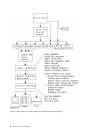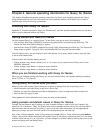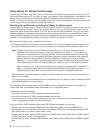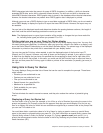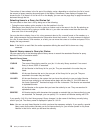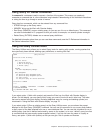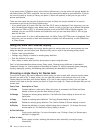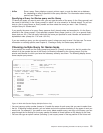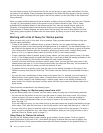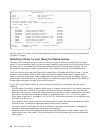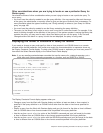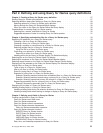You can select as many as 30 queries from the list, as well as type a query name and option in the first
list position of this display. Query processes the requests in the order that they appear in the list, starting
first with the option and query that you typed in the first list position (in the input fields of the Option and
Query columns).
When you select multiple options and the list contains multiple columns of names only (such as in Figure 4
on page 13), the processing order of the columns is top to bottom and left to right. That is, Query
processes all the selected queries in the leftmost column first, then the second column, and so on.
(However, if the selected options include queries that are to be copied or deleted, Copy Queries or
Confirm Delete of Queries displays are shown when the first query with one of those options is found.
Then Query groups together all others with the same option, by library, for you to verify what you want
done.)
Working with a list of Query for iSeries queries
When you work with a list (in this case, a list of queries), Query provides several functions to help you.
Here are some possibilities:
v To see all the queries in a different library or group of libraries, you can press the Enter key after
changing the value in the Library prompt and typing blanks or an asterisk (*) in the Subset prompt. You
are shown all the queries that you have the authority to use that exist in that library or group of libraries.
(You indicate which libraries are to be checked by specifying a library name, a special library name
[such as *LIBL], or a generic library name [in the form of ABC*]intheLibrary prompt.)
v To see a particular subset (a smaller group) of query names, you can type a generic name (in the form
of ABC*)intheSubset prompt and press the Enter key. If you know at least the starting characters in the
name you are looking for, this function can reduce the time needed to locate it.
v To see if more than one library contains a specific query name, you can type that query name in the
Subset prompt and type *ALL in the Library prompt before you press the Enter key. You are shown all
the queries by that name for which you have the authority to use.
v To position the list to a specific name, type the name (or the starting characters in the name) in the
Position to prompt and press the Enter key. This function can also reduce the time needed to locate a
name.
v You can also use a combination of these things at the same time. For example, you could specify a
different library name, generic library name, or special library name in the Library prompt, a subset
value (of query names) in the Subset prompt, a specific query name or the starting characters of a
query name in the Position to prompt, and then press the Enter key to show the desired subset list of
query names.
These functions are described in the following topics.
Selecting a Query for iSeries query name from a list
If you are working with a list of queries, you can select a query by using one of the following methods:
v You can use the top position in the list to type the name of a query (and library name, if the Library
column is shown) you want to create or use. (To select an existing query, it must be available for
use—see “Other considerations when you are trying to locate or use a particular Query for iSeries
query” on page 17.)
If you are creating a query, you can check this list to see what names are already used before you type
a new name. Then, type the new name in the first list position (in its input field) and type a 1 next to it.
v You can work with a query (or queries) in the list by typing an option next to the query(s). (To select a
query, it must be available for use—see “Other considerations when you are trying to locate or use a
particular Query for iSeries query” on page 17.)
Using Query for iSeries list subsets
You can use the Subset prompt to see a smaller group (subset) of query names. To do so, type the
starting characters (in the form of ABC*) that identify the group of queries that you want to display, and
press the Enter key. All the queries whose names start with those characters in the specified library or
14 Query for iSeries Use V5R2



